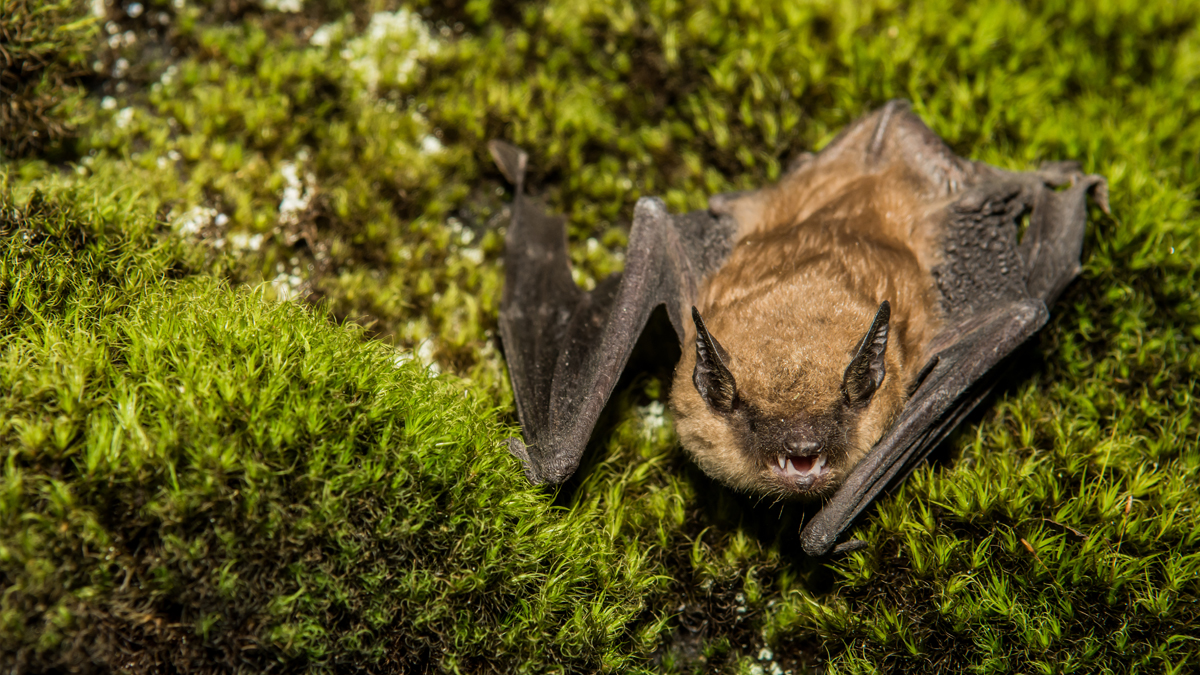At Home With Bats
A take-home STEM unit addresses the declining bat population through problem-based learning.
There are few topics in education that elicit as much controversy as homework. Research offers conflicting conclusions on its effectiveness. Teachers are often faced with the question of what type of homework will improve student understanding, promote responsibility, and strengthen the family-school connection. While few studies look specifically at take-home science for early grades, one study found a positive outcome for both family involvement, science attitudes, and science achievement with interactive homework in middle grades (Van Voorhis 2003). Cooper concluded, “Homework is beneficial as long as teachers use their knowledge of development levels to guide policies and expectations” (2001). Applying the results of these two studies, one can conclude that developmentally appropriate interactive science homework will benefit students in the early grades. It is based upon these principles that the take-home portion of this unit was designed.
This unit was created for first-grade students using both the Next Generation Science Standards (NGSS) and Science, Technology, Engineering, and Mathematics (STEM) in a student-centered, problem-based approach. To begin the unit, Ms. Roberson’s students were asked a simple question. “What animal do you want to learn about?” As with most first-grade classrooms, the room fell silent for a split second and then started buzzing with suggestions. With the first mention of bats, everyone seemed to have an opinion. It didn’t take long to recognize the intense curiosity and misconceptions students had about bats. Bats were described as gross, creepy, and mysterious. Almost every student agreed that they carry diseases and “will drink your blood.” Some kids were not aware bats lived in Georgia, and even a couple were convinced they were extinct. In the end, curiosity gave way to fear and most of the class agreed bats would be a “cool” thing to learn about. Giving students the power to choose their animal of study instantly boosted motivation and participation. Bats being nocturnal makes observing them at school impossible. A multifaceted classroom unit combined with a take-home field study provides students with opportunities to observe and explore bat behavior and habitat and make connections with the natural world. The take-home field study was carefully designed to encourage family participation but was also limited in its scope to ensure student involvement and success.
Introducing the Bats
An effective way to introduce science concepts to young children and spark interest is through literature (Castle and Needham 2007). Ms. Roberson read aloud the book Stellaluna by Janell Cannon (1993). The book demonstrated how parents of different species (bats and birds) care for their young in order to help them survive. Once the story was completed, students of differing ability levels were placed into heterogeneous small groups. Each group was tasked with brainstorming ways in which birds and bats were similar and different. This task provided the teacher with a pre assessment that she used to determine students’ prior knowledge of bats. Although most groups composed similar lists, Ms. Roberson facilitated a class discussion where the group results were combined on a Venn diagram. Ms. Roberson was able to confront any misconceptions held by students and reinforce specific characteristics of bats such as powered flight, echolocation, and nocturnal behavior. Over the period of study, students added facts about both groups of animals to the diagram. A Venn diagram is an effective tool in promoting critical thinking and helped students recognize the structure and function of animals and how they use their body parts differently. Allowing students to compare a familiar animal like birds to a less familiar animal such as a bat helps to boost student confidence and allows students of varying ability levels the opportunity to participate.
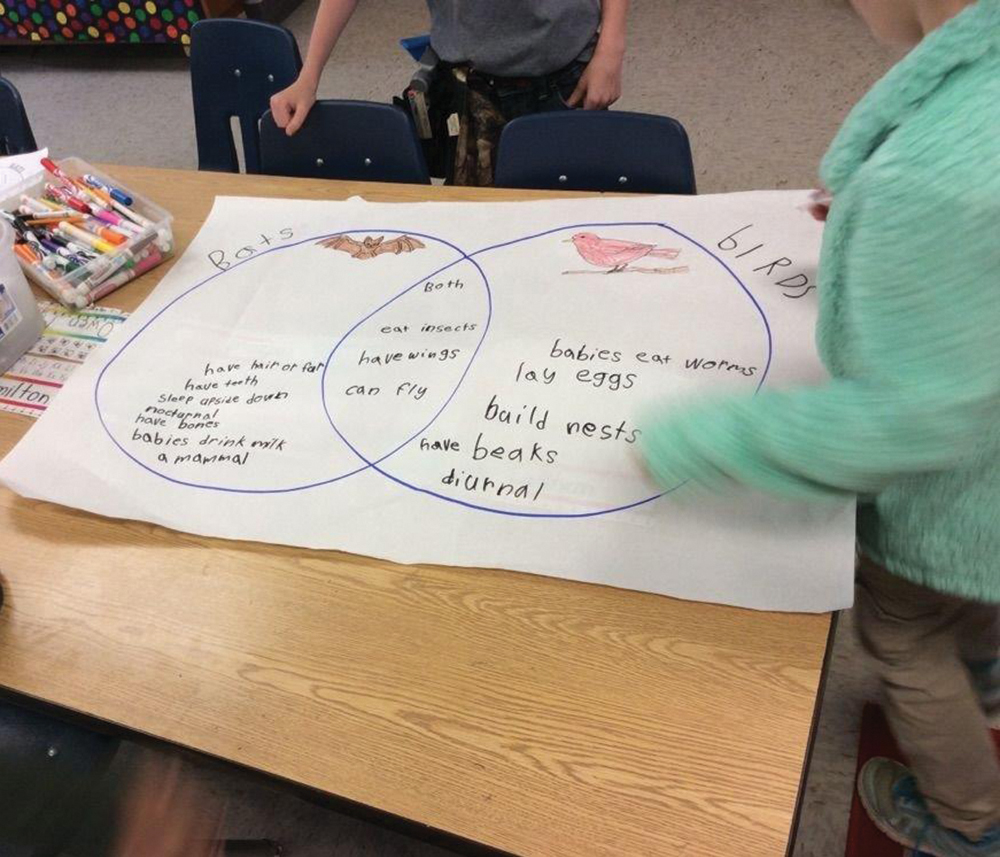
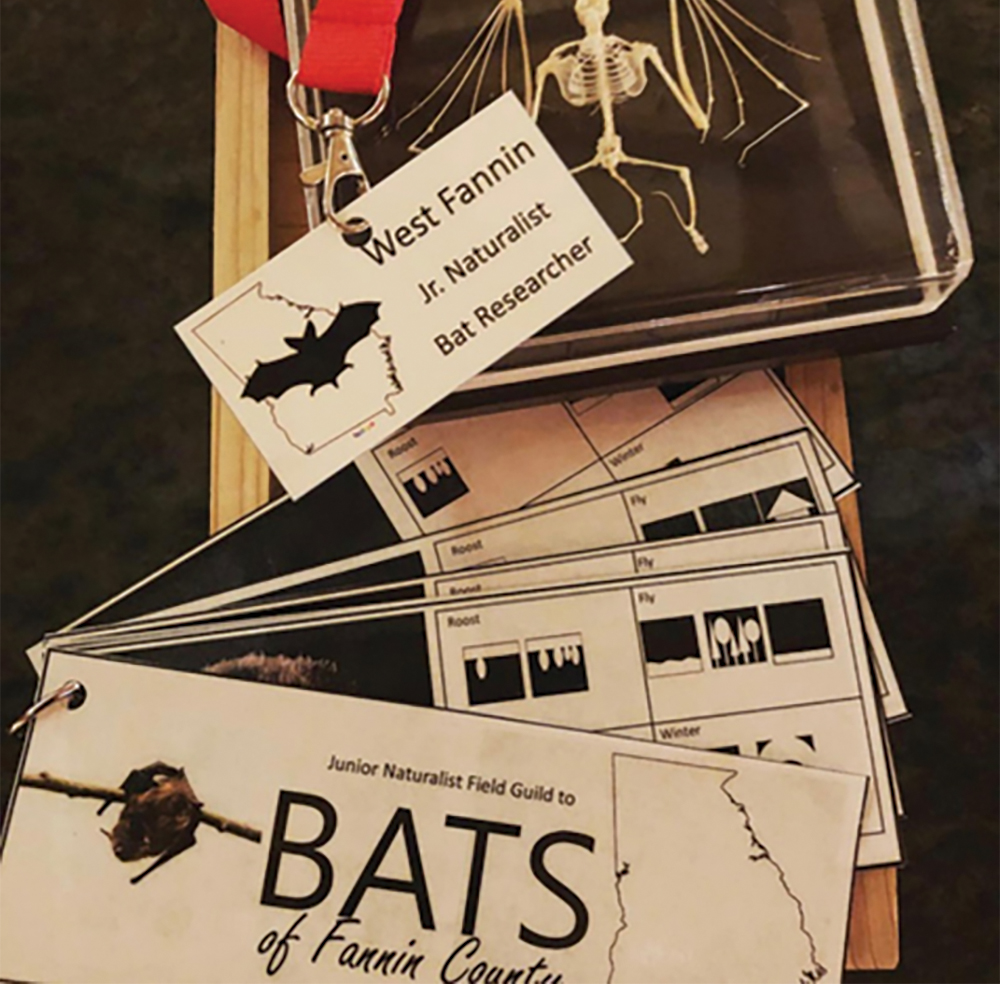
Making a Local Connection
In the elementary classroom, using experts can be very beneficial to science instruction. Experts add something to the curriculum outside of the teacher’s area of expertise and help to establish relationships within the community. It is important to choose someone who is knowledgeable in their field and comfortable speaking with and connecting to younger elementary children. To prepare students to effectively observe bats at home, they attended a “Jr. Naturalist Training” at school where they became “Certified Bat Researchers.” During the training, a master naturalist gave a presentation about native bats. Students received a field guide of local bats which included a picture, a physical description, information pertaining to where bats are found during different seasons, their roosting behavior, feeding behavior, and where each species of bat is most often seen flying. During the presentation, students also observed preserved bats and bat skeletons. They were able to determine how bats used their hands as wings yet were still able to grasp objects and move from place to place by both crawling and walking. Students observed a slow-motion video of a bat catching insects in flight using echolocation and recognized the need for large ears and hind feet as a part of their feeding process. The naturalist informed students of the threats bats can pose to humans. While most bats are not dangerous, they can carry diseases. The most well-known of these diseases is rabies. All scientists who study bats in the field are required to be vaccinated against rabies. Both Ms. Roberson and the naturalist reiterated the importance of never touching a bat, dead or alive. The naturalist shared that the largest threat humans pose to bats in our region is habitat destruction. At the end of the presentation students were able to ask questions and make comments. Once the training was complete, each student was presented with their own Jr. Naturalist badge.
Incorporating Math and Measurement: Bat Lab
In addition to observing bats, scientists in the field often net, measure, and tag bats for population studies. Due to the risk of disease and the fragility of bat populations, this cannot be done in a first-grade classroom. However, it can be simulated in a hands-on approach. Model bats were constructed using paper and attached to carefully measured bags of sand.
In order to make this project relatable and meaningful to students, we selected six bat species of varying sizes native to Fannin County, Georgia. Clip art was used and resized digitally using Microsoft Publisher to create an accurate model of the average body length and wingspan for each species. Bats of the United States (Harvey, Altenbach, and Best 2011) was used as the source for all bat measurements. Once the “bats” were printed (some species require legal paper) and laminated, we filled tiny bags with sand which were then attached with duct tape to the underside of the “bat” bodies. It is important to subtract the weight of the “bat,” baggie, and tape before measuring the sand or the “bat” weights will be less accurate. The bats were not labeled in any way; the only way students could identify the species was by measuring the size and weight.
Students were provided with a table listing the average weights and wingspans of a variety of bat species native to Fannin County (see NSTA Connection). Using a tape measure and a scale, students weighed and measured each bat to determine its species. The measurements for length were made from head to tail in the center of the body. Wingspan was measured from tip to tip. They then classified them accordingly in a data chart. To collect “bats,” the student supervisor selected a “bat” from a designated location in the classroom. After the group finished examining the bat, it was returned and another bat was selected. This not only simulated how a chiropterologist would work in the field, but it also allowed teachers to construct only one set of bats.
For this activity, students were heterogeneously divided into groups of four. To ensure that all students participated, the following rolls were assigned:
- technician— makes physical measurements of each “specimen.”
- chiropterologist— identifies the bat species based on the measurements.
- recorder— records the results in the data chart
- supervisor— responsible for checking the work of other group members.
Once two bats were successfully identified, the students changed roles, allowing each student the opportunity to measure, identify, record, and supervise.
Take-Home Observation Study
The take-home field journal is at the center of this unit—parent involvement and supervision are key components of student success. To ensure cooperation, a letter was sent home to inform parents of the monthlong bat study (see NSTA Connection). The letter outlined specific instructions for observing bats and recording data in the field journal. During class, students brainstormed areas that were most likely to have bat activity. From the discussion, students concluded that bats in our area are most commonly observed near water, in open spaces along forest edges, near old barns or buildings, and near street lamps. Ms. Roberson reminded students that they do not need to “go somewhere” to see bats. Ultimately most students selected areas near their homes and a few selected parks or family members’ homes. In an effort to maintain the authenticity of the unit, students were asked to obtain the GPS coordinates of their observation location. To find GPS coordinates, students entered the street address for the location they chose into the website . Students were tasked with returning to this location each day at twilight for a month to observe and record the weather conditions and the number of bats present. Ms. Roberson emphasized that not seeing bats was just as important to the study as seeing them. Weather conditions were recorded each day regardless if bats were present or not. Some students did not observe any bats due to the location of their homes. The primary objective of the field study was to identify the problem that students will later solve.
Compiling Results With Technology
Students compiled their data from the field study using Google Forms to identify a pattern of bat behavior and habitat. Students found that bats are most often seen on calm, clear evenings where temperatures are above 60 degrees Fahrenheit. Students who lived near water or heavily forested areas recorded seeing more bats than students who lived in town or near busy roadways. Some students noted seeing bats near abandoned structures. Overall, students expressed that they saw fewer bats than expected and wanted to find ways to encourage more bats to live near their homes.
Discovering a Solution
Ms. Roberson shared the results of the data collection on the smartboard and opened the class discussion with the following question, “What can we do to encourage more bats to live near your home?” Students offered a variety of solutions, such as adding a swimming pool or pond near their home or planting trees in some areas and removing trees from others. One student suggested building a barn for bats, which helped Ms. Roberson target the conversation by asking, “Is there an easier smaller structure we can build.” One student, recalling the training with the Master Naturalist finally suggested building a bat house. The class agreed that constructing a bat house would be the best option for attracting bats. One student added that she wanted to build a house for baby bats. Ms. Roberson reminded students that bats, unlike birds, are picky about where they roost and challenged students to find the best designs and specifications for constructing a bat house. She also mentioned that bat pups stay with their mothers like other mammals and suggested students look for any special criteria to that would encourage mama bats to choose their house. To do this, students were given access to a variety of books (see Resources) and utilized the Bat Conservation International (BCI) website.

One of the greatest challenges in working with first-grade students is their wide-ranging reading ability. For the research portion of the unit, we chose to separate students into three groups. The first group was comprised of independent readers who worked with partners to navigate the BCI webpage and an assortment of books to collect information. They were each given a guide sheet to assist with their search. A second group of developing readers worked in a small group with a paraprofessional educator. They read through the website and reference books using the same guide sheet, but additional assistance was available when needed. Ms. Roberson worked with the group of emerging readers. As a group, they completed the guide sheet while Ms. Roberson read aloud information from the website and print resources. All three groups shared the same goal: to identify the best structure for housing bats and any specifications that would increase the likeliness for bats to roost and raise their pups.
Evaluating Bat House Designs
Through their research, students identified a chambered bat house as the best structure to encourage bats to roost near their homes. Students read about the design challenges and failures that led scientists to agree on a specific range of specifications. Working within these parameters, students had to apply their knowledge of bats present in our area and temperature data from our area to determine the exact height and width of their bat house, the number of chambers they wanted to include, and how far apart they wanted their chambers to be placed. Students also had to choose a material for the footholds of the landing, select a color to paint the house, and determine the type and height of pole or beam the house would be mounted on and how it would be attached. The following specifications were obtained from Bat Conservation International’s Bat House Builders Handbook and were provided to students while determining how to construct the bat house:
- Bat houses should be at least 20 inches tall and 14 inches wide
- Three chambers or more is best
- Roost partitions should be space ¾— 1 inch apart (spacing depends on the bat species you want to attract)
- Partitions and landings must provide footholds for bats
- 1- to 2-inch-thick boards of plywood are best
- Pressure-treated lumber must be sealed and painted
- All seams must be sealed Bats prefer houses that are between 80 and 100 degrees Fahrenheit. Darker paint should be used for colder climates, lighter for warmer climates. In very warm climates houses must be vented.
- Bat houses need at least six hours of direct sunlight each day.
- Bat houses must be mounted on poles 15 feet above ground to protect against predators.
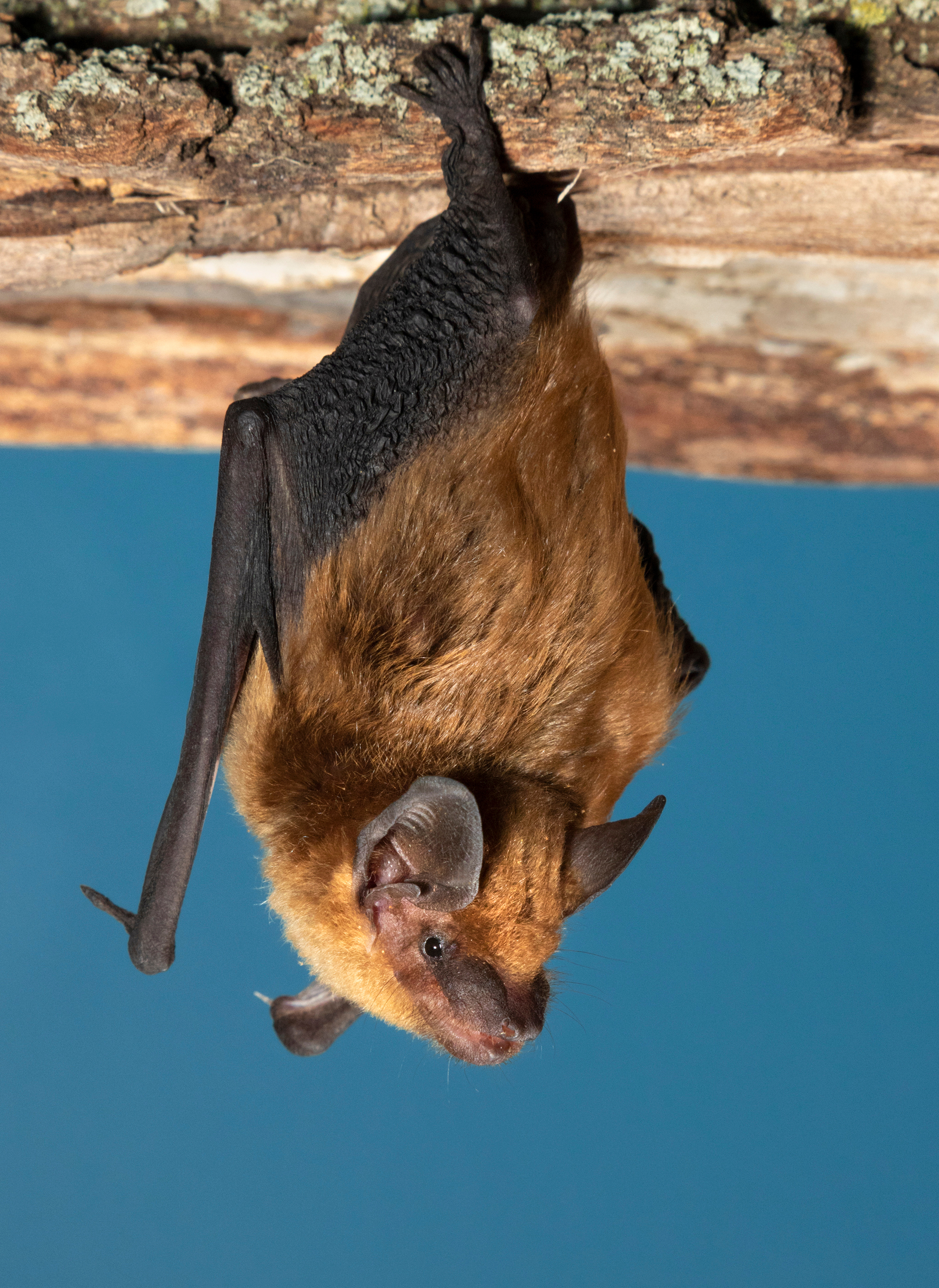
To ensure all students would be able to participate in the construction of a bat house, one was constructed in class. In order to choose the best design for the class bat house, each group posted a sketch of their design along with the specifications. Under each sketch was a brown paper bag. Students were each given three tokens. To vote, students placed a token in the bag of their top three designs, and the design with the most tokens was chosen for construction. To collect materials, we asked for donations from our school community. Most of the materials were unused scraps that parents were happy to share. Donations from local hardware stores or construction companies are also a great resource for obtaining building materials. Parent volunteers assisted with the construction and provided pre-cut, pre-drilled plywood pieces. Students who chose to participate in the drilling, caulking, and painting of the bat house wore protective goggles to protect against saw dust and accidental paint splash. Students who caulked the seams also wore latex gloves. Families were encouraged to build their own bat houses for their homes as well. Any interested families were provided with a copy of the Bat Conservation International Bat House Builder’s Handbook. Only a few families constructed their own bat house during the first year of our project, but many expressed interests in purchasing Bat Conservation International approved pre-built bat houses. These pre-built houses follow the same specs as outlined in the handbook. This is also a great option for teachers looking to complete this project but are unable to access the tools, time, or materials needed to construct a bat house from scratch.
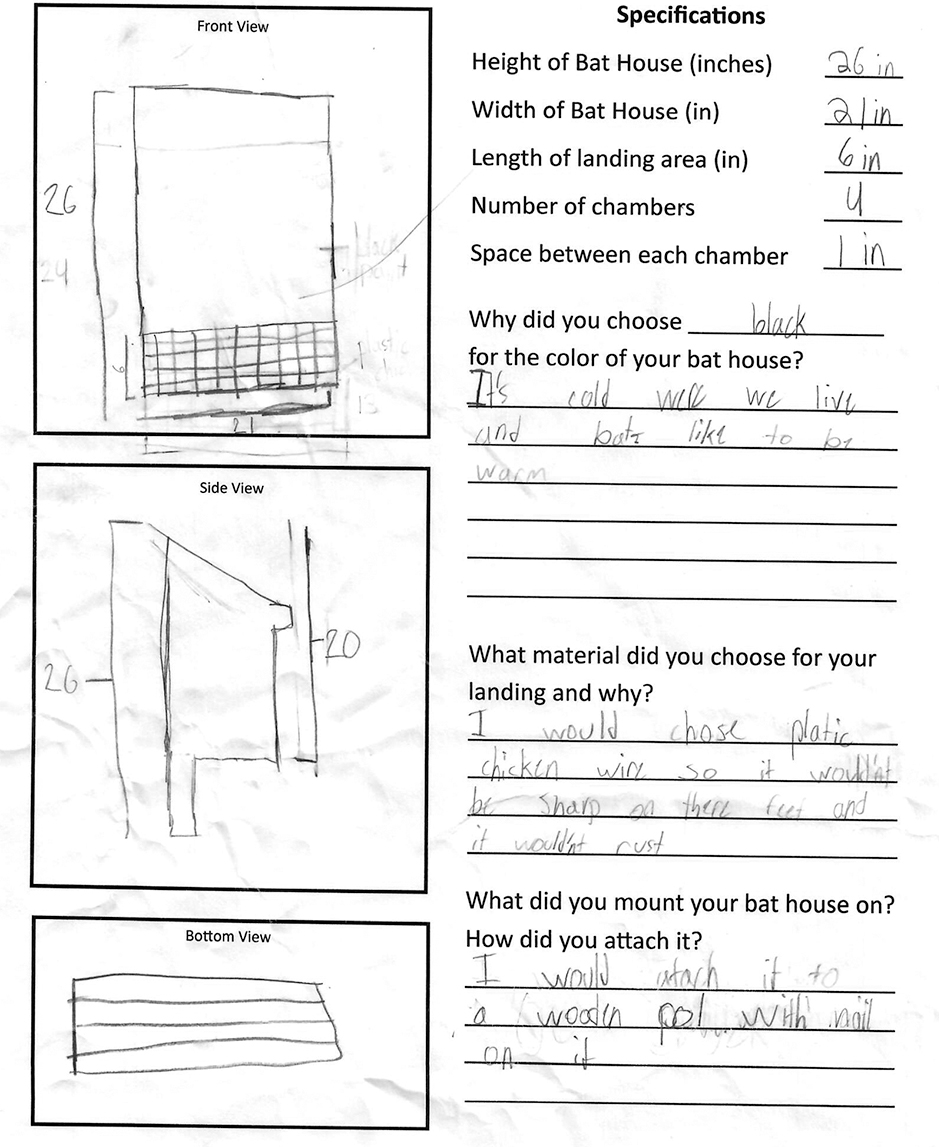
Assessment
To gauge student understanding and encourage communication, Ms. Roberson asked questions of students throughout the unit. Questions were designed to help students construct new ideas from prior knowledge. Often a one-on-one discussion or interview helped Ms. Roberson determine each child’s level of understanding. Students also produced a portfolio to serve as a formative assessment. It included a KWL chart; an individual copy of the completed class Venn Diagram; a copy of the Bat Lab; the field study that included their data collection and the compiled class data; an illustration and written description of the area they observed; the guide sheet from their online research; and a sketch of their proposed bat house. The last portion of the portfolio was an individual “Bat Report.” Students wrote four complete sentences about bats and their habitats and gave a presentation to their classmates. Students had to provide an illustration of a bat in its habitat. As an extension, students could be given the opportunity to choose a specific species of native bat and complete the project with species-specific descriptions of habitat and behavior. Students with limited writing abilities were able to provide an oral report to their peers or to Ms. Roberson privately.
Reflections
The application of the NGSS, engineering practices, and crosscutting concepts led students to apply their knowledge of bats to interpret firsthand data and to recognize patterns of bat behavior. The observations and data collected during the take-home portion of this unit led students to ask questions about how bats survive and helped students identify that a lack of roosting space was one problem leading to fewer bats in each area. Through targeted research, students cooperated in teams and determined that the construction of a bat house offered the best solution. Students were encouraged to evaluate current bat house designs and decide how the design could be adapted or improved to best meet the needs of the bats in their region. Students realized that the shape and stability of the bat house was directly tied to how it functioned. For example, a larger darker colored bat house would provide more warmth and would therefore be more likely to be used by bats as a nursery house for rearing pups. Students drew on their knowledge of the local climate and species of bats native to our region to determine house color and chamber spacing. Prior to construction, students created a sketch with a list of specifications to illustrate why their design was the best choice for the school bat house. A winning design was chosen and constructed. This unit encouraged engagement by giving students ownership throughout every facet of the project. Once the school-based bat house was erected, students expected bats to immediately move in. Unfortunately for the students, that was not the case. They learned that biology moves slowly, and an authentic biological study often takes years to see results. Students will continue to monitor bats by surveying populations each spring. If populations do not begin to increase after two years, students will be challenged to make changes to the design or location of the bat house. Students have already suggested adding an additional water source and bat-attracting plants. A key benefit of utilizing engineering concepts in the classroom is that there are no failures, only opportunities for learning and continued improvement.



